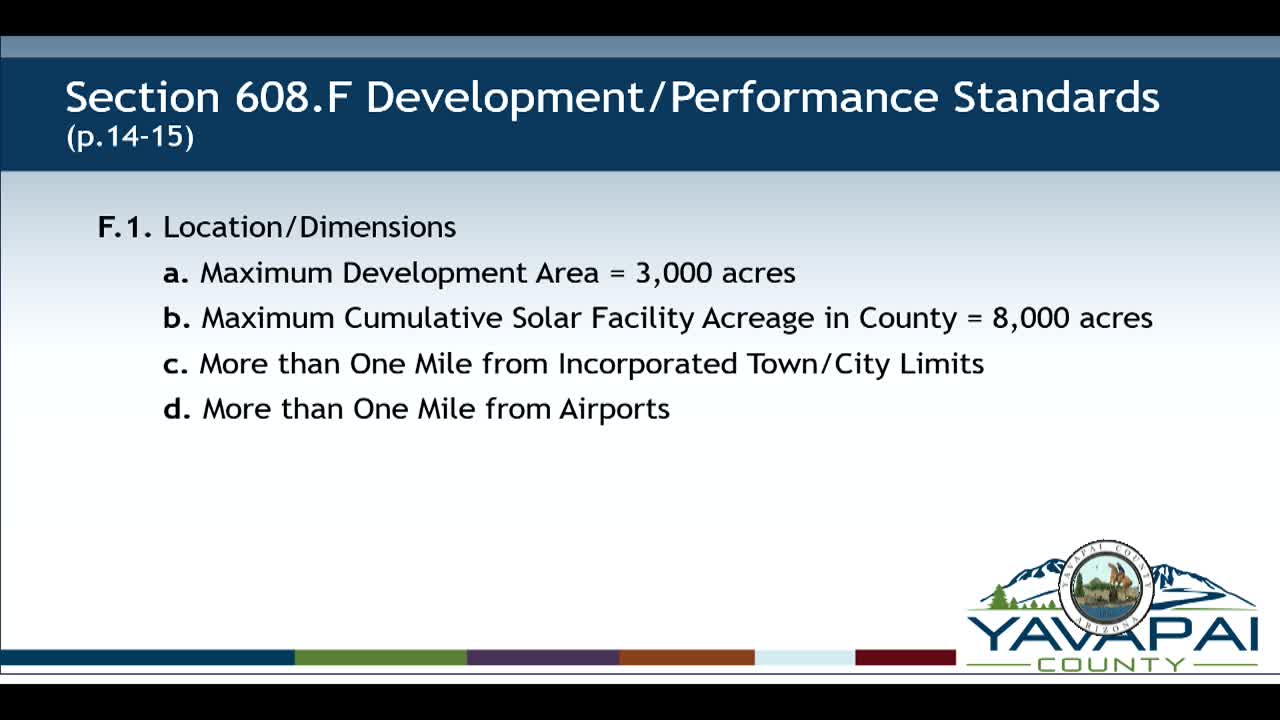Solar Development Sparks Debate Over Land Use Regulations
June 19, 2024 | Yavapai County, Arizona

This article was created by AI summarizing key points discussed. AI makes mistakes, so for full details and context, please refer to the video of the full meeting. Please report any errors so we can fix them. Report an error »

In a recent government meeting, officials discussed critical parameters for land use and development, particularly focusing on utility-scale solar projects. The conversation centered around the maximum development area, with a proposed cap of 3,000 acres for buildable space and a cumulative limit of 8,000 acres. This cap aims to balance industry demand with environmental considerations, as officials noted a surge in interest for solar installations.
Participants highlighted the importance of strategic land use, emphasizing that future developments must consider proximity to residential areas, airports, and environmentally sensitive sites. A minimum buffer of one mile from incorporated towns and airports was proposed to mitigate potential conflicts with local communities and aviation regulations.
The discussion also touched on performance standards for site selection, advocating for the use of previously disturbed lands, such as brownfields and mine sites, while avoiding areas with significant ecological or cultural value. Officials expressed concerns about the visual impact of solar installations, suggesting that sites near highways or existing industrial areas may be more suitable.
Setback requirements were another focal point, with proposed distances of 500 feet from residential and commercial zones, and 300 feet from highways. These measures aim to protect local habitats and ensure that solar facilities do not encroach on vital wildlife corridors or culturally significant sites.
The meeting concluded with a call for feedback from industry stakeholders and the community, emphasizing the need for a flexible approach to land use regulations that can adapt to changing demands while safeguarding the environment. As the region navigates the complexities of renewable energy development, officials remain committed to finding a balance that supports growth while preserving local resources and landscapes.
Participants highlighted the importance of strategic land use, emphasizing that future developments must consider proximity to residential areas, airports, and environmentally sensitive sites. A minimum buffer of one mile from incorporated towns and airports was proposed to mitigate potential conflicts with local communities and aviation regulations.
The discussion also touched on performance standards for site selection, advocating for the use of previously disturbed lands, such as brownfields and mine sites, while avoiding areas with significant ecological or cultural value. Officials expressed concerns about the visual impact of solar installations, suggesting that sites near highways or existing industrial areas may be more suitable.
Setback requirements were another focal point, with proposed distances of 500 feet from residential and commercial zones, and 300 feet from highways. These measures aim to protect local habitats and ensure that solar facilities do not encroach on vital wildlife corridors or culturally significant sites.
The meeting concluded with a call for feedback from industry stakeholders and the community, emphasizing the need for a flexible approach to land use regulations that can adapt to changing demands while safeguarding the environment. As the region navigates the complexities of renewable energy development, officials remain committed to finding a balance that supports growth while preserving local resources and landscapes.
View full meeting
This article is based on a recent meeting—watch the full video and explore the complete transcript for deeper insights into the discussion.
View full meeting
